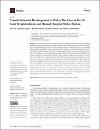Transit‐Oriented Development in Doha: The Case of the Al Sadd Neighborhood and Hamad Hospital Metro Station
| Author | Nafi, Sara |
| Author | Furlan, Raffaello |
| Author | Grosvald, Michael |
| Author | Al-Matwi, Rashid |
| Author | Marthya, Khalida Lifam |
| Available date | 2022-01-30T10:43:25Z |
| Publication Date | 2021 |
| Publication Name | designs |
| Identifier | http://dx.doi.org/10.3390/designs5040061 |
| Citation | Nafi, S.; Furlan, R.; Grosvald, M.; Al‐Matwi, R.; Lifam Marthya, K. Transit‐Oriented Development in Doha: The Case of Al Sadd Neighborhood and Hamad Hospital Metro Station. Designs 2021, 5, 61. https://doi.org/10.3390/ designs5040061 |
| Abstract | Over the last two decades, transit‐oriented development (TOD) has been widely implemented as an integrated strategy to enhance urban livability. Doha, the capital of the State of Qatar, has faced urban challenges such as excessive reliance on private vehicles, absence of a well‐established public transportation system, and issues with integration of last‐mile connectivity. This research study explores Al Sadd, a mixed‐use neighborhood in Doha, in order to investigate key factors to be addressed for enhancing urban livability within this neighborhood. These factors were analyzed through a combination of qualitative and quantitative methods incorporating: (1) a literature review focusing on sustainability, smart growth, and transit‐oriented development; (2) data collection and analysis utilizing oral and visual data from the Qatari Ministry of Municipality and Environment (MME), Qatar Rail, and private engineering and consulting companies; and (3) analytical and applied study through site analysis, observation, photographs, and field notes. A regeneration master plan for the study area proposes the creation of avenues for urban interaction through the introduction of community open spaces, pedestrian‐friendly streets, and other measures promoting city compactness. The outcome of this research study illustrates how the enactment of a TOD model can lead to smart growth and eco‐friendly urban living by emphasizing TOD principles which promote a pedestrian‐oriented neighborhood. |
| Sponsor | This research study was developed under the grant schemes awarded by (i) Qatar National research Fund [QNRF] a member of Qatar Foundation: Grant ID: GSRA7‐1‐0502‐20030; and (ii) Qatar University [QU]: Grant ID: QUCP‐CENG‐2021‐2 [NATIONAL CAPACITY BUILDING PROGRAM‐NCB‐S1], titled: Re‐thinking a Framework for the Urban Regeneration and Preservation of the Transit Villages of Old Salata, QNM, Msheireb and Souq Waqif. English editing, proof‐reading, and article processing charge (APC) were fully supported by Qatar University, under Grant ID: QUCP‐CENG‐2021‐2 [NATIONAL CAPACITY BUILDING PROGRAM‐NCB‐S1]. |
| Language | en |
| Publisher | MDPI |
| Subject | smart growth transit‐oriented development Doha Metro Al Sadd |
| Type | Article |
Files in this item
This item appears in the following Collection(s)
-
Civil & Architectural Engineering [681 items ]
-
English Literature & Linguistics [99 items ]


